When it comes to staple plants often found in Australian gardens, bottlebrushes or Callistemon plants are definitely a stand out feature. These brilliantly blooming plants offer a striking garden display while being perfectly adapted to thrive in a range of Australian climates.
Callistemon phoeniceus is a fiery species of Callistemon, with an incredible adaptability to soils with poor drainage. With a low, shrub-like growth habit, and striking summer blooms, it’s a great choice for a range of garden landscapes.
Here is everything you need to know to cultivate, care for and grow Callistemon phoeniceus.
More...
Callistemon phoeniceus Features
Family: Myrtaceae
Genus: Callistemon
Species: phoeniceus
Common Name: Scarlett Bottlebrush, Fiery Bottlebrush, or Lesser Bottlebrush
Flower Colour: Red
Foliage Colour: Grey-Green
Growth Habit: Shrub to 2m
Flowering: Spring to Summer
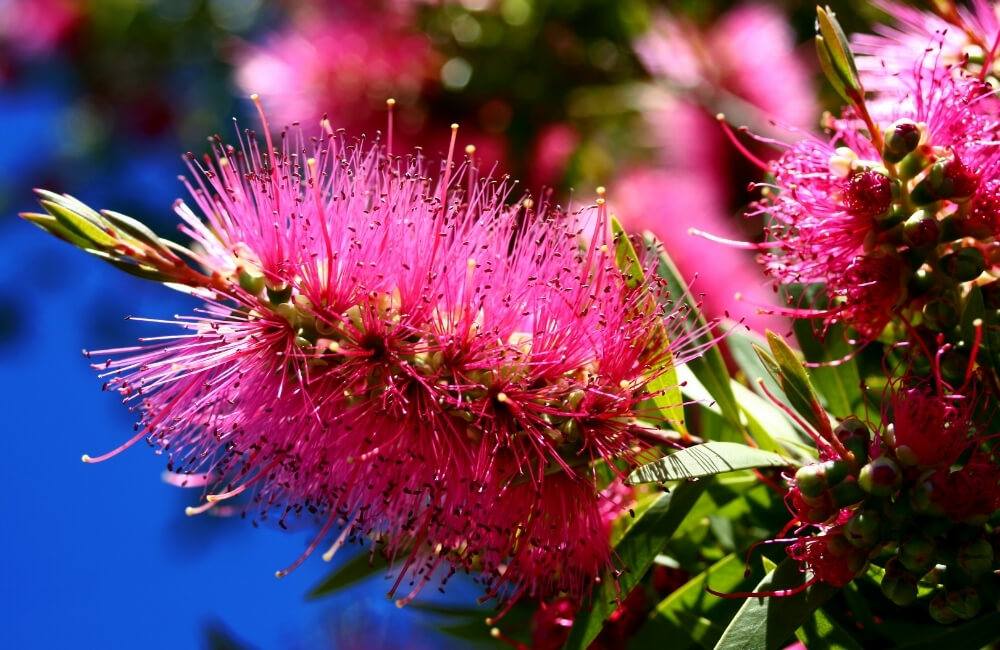
Part of the Myrtaceae family, Callistemon plants are a popular plant species in Australia. With around 50 species of plants, which bloom in a range of brilliant colours, they offer gardeners a wide range of planting opportunities.
With long elliptical, evergreen leaves and bright, cylindrical flowers, these species are often referred to as bottlebrushes, but don’t let the name deter you.
These plants are a stunning attraction for gardens, particularly in the spring and summer periods. The Callistemon phoeniceus is one of only two Callistemon species that are endemic to Australia.
This is a smaller growing species of bottlebrushes and is prized for its red and pink-tinged flowers which have given it the more common name of Scarlet Bottlebrush. Other names for this species include the fiery bottlebrush or lesser bottlebrush.
Found growing naturally along the southwest region of Western Australia, the Callistemon phoeniceus is best suited to slightly colder temperatures. However, this hardy plant will happily establish itself almost anywhere.
How to Grow Callistemon phoeniceus
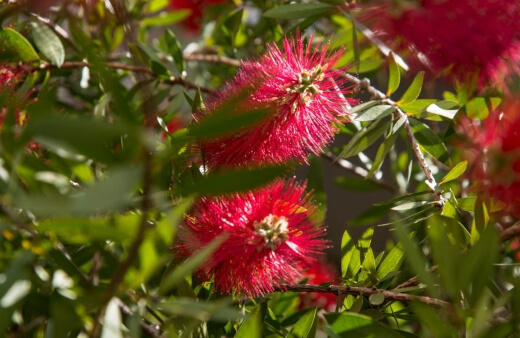
This species of bottlebrushes is known to have a particularly vigorous growth habit, especially when grown in moisture-rich soils. Still, in order to produce a bountiful bloom, it will need plenty of sunlight.
Even for beginner gardeners, this species is known to be particularly easy to grow and as it is so hardy, it is even harder to kill.
Sunlight
These plants prefer an open and sunny position to grow in. Still, some varieties have been proven to grow in lightly shaded areas too.
For the best results, pick a position in your garden where your plant will receive the most sunlight during the day.
Soil
Unlike most other bottlebrush species, the scarlet bottlebrush fares particularly well in wetter conditions. Whether in loamy, sandy or clay soils, this species prefers moist soils that still provide adequate drainage so the roots are not sitting in water.


Get Your Free Guide:
Master Growing Australian Natives eBook
A Must Have Complete Guide for Every Australian Garden
Get Your Free Guide:
Master Growing Australian Natives eBook
A Must Have Complete Guide for Every Australian Garden
If planning on growing Callistemon phoeniceus in a pot, be sure to make use of a loose, free-draining potting mixture. You will also need to ensure that the chosen pot has plenty of drainage holes to allow water and moisture to escape.
Temperature
The scarlet bottlebrush is best suited to cooler climates. However, it can still be grown in warmer regions and coastal areas across Australia.
More so, this species is not known to be affected by cold winds or frost. So, it will not require any special attention during the winter.
Propagating Scarlet Bottlebrush

As with other callistemons, this species can be freely propagated from both seed and semi-hardwood stem cuttings.
Propagating Lesser Bottlebrush from Seed
Seeds are often best obtained from an online plant nursery, which guarantees germination. Many native seeds can remain dormant for long periods of time, making germination a long and challenging process.
Seeds can be sown at any point in the year. However, better results occur when sown in spring or autumn, as the ideal germination temperature is between 18-22°C.
Here is what you’ll need to do:
- Prepare a small pot or seedling tray with a porous seed-starting mixture.
- Sow the seeds directly onto the surface of the soil. Take care not to bury the seed deep into the soil.
- Water well once, which will allow the seed to lodge itself into the soil.
- Thereafter, keep the soil moist by regular misting. This will avoid disturbing the seed too much during germination.
- Keep your seedling in a warm and sunny spot until germinated.
Germination can take anywhere between 14 to 28 days. Again, some seeds remain dormant until ideal conditions arise. As such, you may need to be patient. Avoid discarding seeds too early when you’re not seeing results.
Once your seedling is large enough to handle it can be re-planting into a larger pot or directly into the growing site.
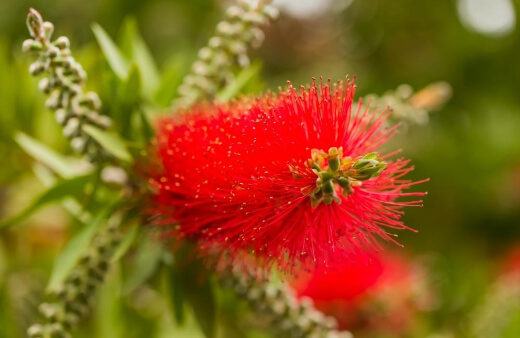
Propagating Fiery Bottlebrush from Cutting
Cuttings should be taken in late summer, allowing young plants to establish themselves before the winter chill. Be sure to take cuttings from healthy, thriving parent plants to ensure the best results.
Here is what you’ll need to do:
- Remove a stem cutting around 4 to 8 centimetres in length. Your cutting should have at least 4 to 5 leaves at the tip.
- Dip the cut end into a rooting hormone and plant into a small pot with a rich potting mix.
- Keep your cutting moist for the first few weeks, while allowing the soil to drain adequately in between.
- Keep your plant in a warm and sunny spot for the best results.
Once new growth appears, cuttings can be re-planted into larger pots or the growing site. For the ideal growth, replant during the growing season in spring or summer.
Planting Callistemon phoeniceus
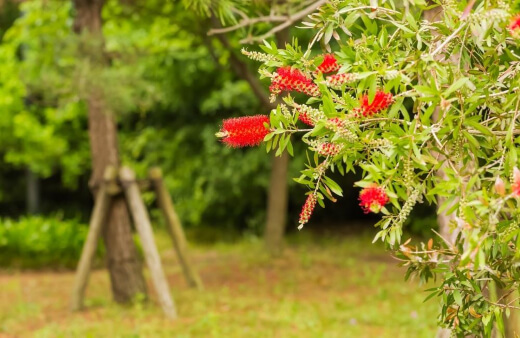
Planting your scarlet bottlebrush is fairly easy and should be done during the spring or summertime for the best results.
You will need to prepare your planting site, and while it is not necessary, a slow-release, granular fertiliser can be added to the soil to give your plants a little nutritional nudge after planting. (Get to know more about fertilisers and which to use depending on your plants' needs.)
- Dig a hole that is large enough to fit the root ball. For cutting, this hole will not need to be very big.
- Place the root ball into the soil and backfill, gently pressing down the soil to remove any major air pockets and to stabilise your plant.
- For this species, it is recommended to create a small doughnut around the base of the plant. This will help to retain moisture around the root system.
- Water well after planting.
Depending on where you decide to grow your scarlet bottlebrush, mulching after planting can help to support the plant and deter weeds around the base of the plant.
This is a particularly good idea when growing Callistemon phoeniceus in pots. A sugar cane or wood chip mulch is advisable. Be sure to check our ultimate guide on the types of mulch, as well when and how to use them.
Caring for Lesser Bottlebrush
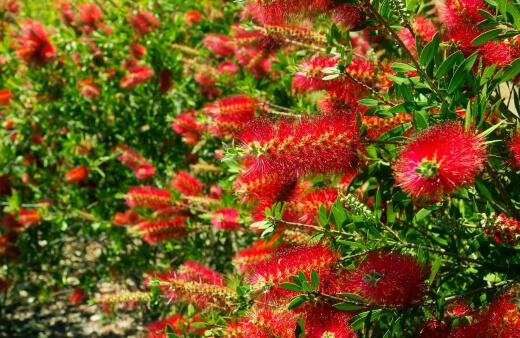
This species thrives with added moisture, so your most important care instruction is to keep the soil well-watered. A good weekly soaking will do the trick.
You will want to avoid waterlogging the soil, so be sure to allow the soil to dry out from time to time. Overly wet soil can cause issues when it comes to disease and root rot.
While it is not always necessary after planting, a general-purpose, balanced native fertiliser can be added annually in the early spring to support new growth and fresh blooms in the summer.
Avoid fertilising in the colder months as this can have adverse effects. The scarlet bottlebrush responds well to light pruning from time to time.
While it is not advisable to cut growth back aggressively, trimming stems and spent flowers will encourage growth and allow for plant shaping.
Be sure to use a sharp pair of shears (if you don't have one yet, our review on the best secateurs will help you choose the right one for you) so as not to cause any unnecessary damage to young stems.
Common Fiery Bottlebrush Pests, Problems & Diseases
These plants are known to be hardy, so potential infestations or disease issues are not a major concern for growers.
Still, plants can be susceptible to issues when soils are overly wet or common garden pests rear their head. Keep an eye on your plants and foliage to locate any issues in this regard early on.
Garden pests such as scale insects or mites can be treated with a horticultural spray or a strong stream of water. Cut back any areas which have persistent pest issues.

Source: scienceimage.csiro.au
With callistemon plants, another cause for concern is Callistemon Sawfly Larvae, which feed and destroy the leaves of your plant. These are best controlled by physically removing them from leaves or a strong jet of water.
It is essential to regularly check leaves and continually spray your plant to curb the issue.
Callistemon phoeniceus Frequently Asked Questions
Is Callistemon phoeniceus the same as Melaleuca phoenicea?
Callistemon phoeniceus is the same plant as Melaleuca phoenicea, and technically the wrong name. Reclassifications have evidenced that Callistemon phoeniceus is in fact a Melaleuca species, but it is still commonly referred to as Callistemon phoeniceus throughout Australia.
What are other common names for Callistemon phoeniceus?
Other common names for Callistemon phoeniceus include the Bottlebrush Tree and the Scarlet bottlebrush. Unlike most plants that receive the same moniker, the brush-like flower heads of Callistemon are completely scarlet and evenly bristled, creating long, dazzling displays.
What are the benefits of the bottlebrush tree?
Bottlebrush trees (Callistemon phoeniceus) have antifungal and antibacterial properties and can be used to ease the symptoms of many diseases in common herbal medicine.
As well as their general antibacterial and antifungal properties, they have effective insecticidal uses too, and simply planting them in the garden can help to deter problem pests.
When should you prune a bottlebrush tree?
The best time to prune bottle brush trees is late winter or early spring, just as the leaf buds begin to show signs of new growth, but before they are open. This is a good indication that your bottlebrush is ready to prune, and ready to send up new shoots afterward.
How to prune a bottlebrush tree?
Prune bottlebrush trees back by about 1/3 each year to maintain a good shape. They can be allowed to grow without pruning, but to maintain a neat shrub, it's best to cut back each branch by at least four buds, triggering bushier, healthier growth, and more flowers.
What is the lifespan of Callistemon phoeniceus?
Callistemon phoeniceus can live for up to forty years, re-flowering actively each year. After about thirty years, the flowering may show signs of slowing down, so it’s a good idea to take cuttings and grow your own replacement.
Does Callistemon phoeniceus have invasive roots?
Callistemon phoeniceus does not have invasive roots. While they are deep rooted, and can send up volunteers from their root system, callistemon will not damage property or solid structures with its roots.
Is Callistemon invasive?
As well as having fairly gentle roots, callistemon is slow to spread, and will not self-seed easily in the garden, making it a great low-maintenance shrub for any Australian garden.
If you do notice new callistemon plants popping up, simply dig them out and make use of them somewhere else, or let them grow on for a fuller border.
Can you keep a bottlebrush tree small?
You can keep bottlebrush trees small with regular pruning (once in autumn and again in spring), but it’s also important to make sure any potted callistemon is given a biennial root prune.
Callistemon in the ground will manage their own root system, but for heavily pruned, ornamental shrubs in pots or containers, pruning the roots gently every two years will keep them healthy.
How quickly does callistemon grow?
Callistemon, the bottlebrush tree, grows reasonably quickly, but don’t expect fireworks in your first year. 20-30 cm of growth per year is the most you should expect from any callistemon, but they will eventually reach 20 feet or more.
Where does Callistemon phoeniceus grow best?
For the best flowering display, you’ll need to plant your Callistemon phoeniceus in full sun, with an absolute minimum of 6 hours of direct light per day. After the first couple of years, they won’t need watering, but providing some support with regular irrigation for the first two summers will help them to establish in most soil conditions.
Does Callistemon phoeniceus attract butterflies?
Callistemon phoeniceus is a great plant to attract moths and butterflies into the garden. Its open flowers, with deep nectar resources are an alluring sight for any butterfly, and its red flowers help to signal the availability of nectar, so you’ll be bringing all sorts of wildlife into the garden with these stunning shrubs.
Are you considering adding some other callistemons to your garden landscape? Take a look at our growing guides:
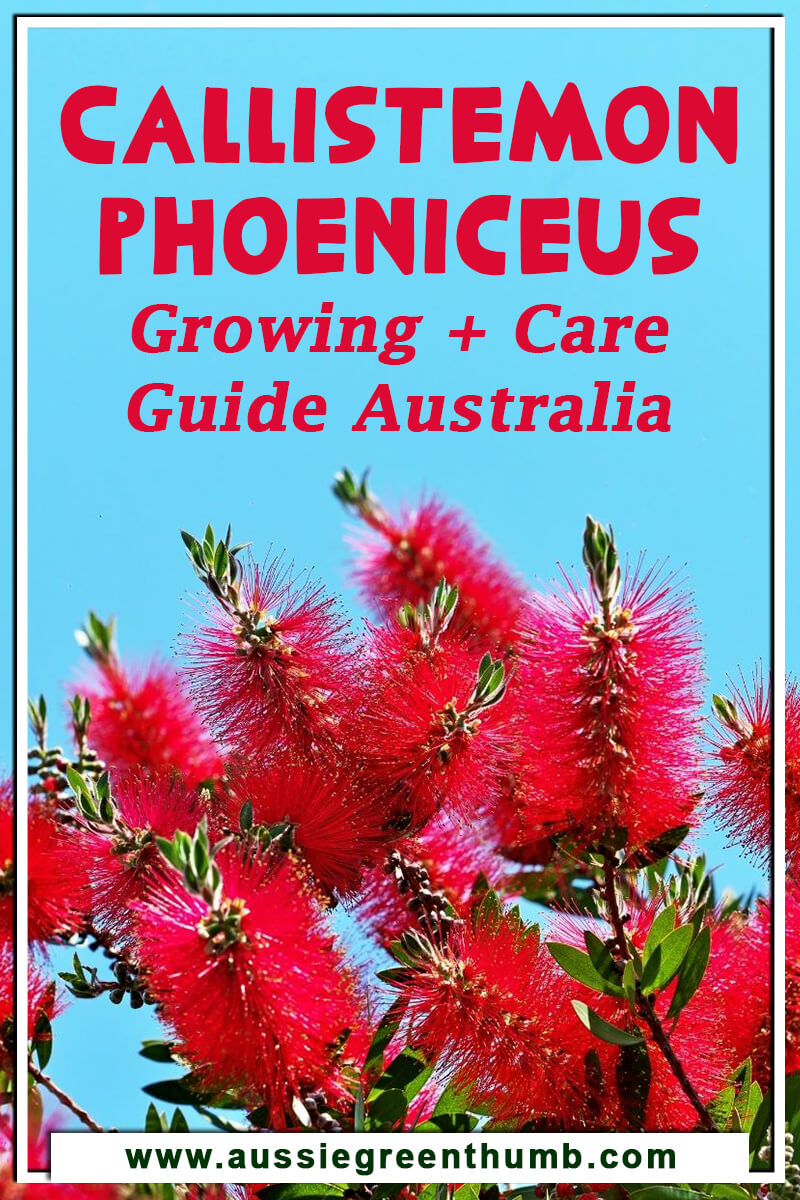
Start Growing Callistemon phoeniceus in Your Garden
So, there you have it. Everything you need to know to grow this incredible species in your garden. Especially in areas with moist soils, the Callistemon phoeniceus is a perfect choice as it's hardy and adaptable and will still provide a wealth of beautiful, bottlebrush blooms where other varieties may not.
Published on January 16, 2023 by Lorri Hopkins
Last Updated on January 21, 2025




